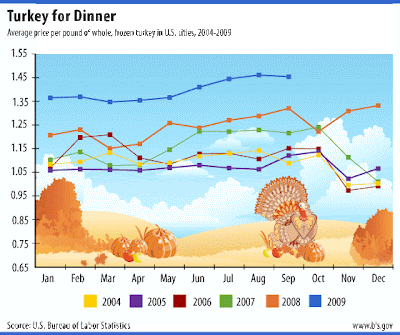
In 2008, their tab for Thanksgiving dinner came in at $44.61, which was up $2.35 (or 5.6%) from what they found in 2007. Their press release describes the big movers:
The cost of a 16-pound turkey, at $19.09 or roughly $1.19 per pound, reflects an increase of 9 cents per pound, or a total of $1.46 per turkey compared to 2007. This is the largest contributor to the overall increase in the cost of the 2008 Thanksgiving dinner.
"Food prices rode the energy price roller coaster up during the first half of 2008, and as the year winds down, energy prices have moderated somewhat but food prices have not come down," said Jim Sartwelle, an AFBF economist.
For 2009, the AFBF is reporting that assembling their classic Thanksgiving dinner costs 4% less than in 2008:
AFBF's 24th annual informal price survey of classic items found on the Thanksgiving Day dinner table indicates the average cost of this year's feast for 10 is $42.91, a $1.70 price decrease from last year’s average of $44.61.
[...]The cost of a 16-pound turkey, at $18.65 or roughly $1.16 per pound, reflects a decrease of 3 cents per pound, or a total of $.44 per turkey compared to 2008.
Milk, at $2.86 per gallon, dropped $.92 and was the largest contributor to the overall decrease in the cost of the 2009 Thanksgiving dinner.
"Consistent with the retail food price declines seen throughout the year, consumers will pay just a bit less for their Thanksgiving feast this year," said Jim Sartwelle, an AFBF economist. "Consumers are benefiting at the grocery store from significantly lower energy prices and the effects of the economic slowdown. Again this year, the cost per person for this special meal is less than a typical 'value meal' at a fast-food outlet," Sartwelle said.
So we find that even though the price of Thanksgiving dinner has decreased, the price of turkey would appear to not really have budged much from its 2008 price.
 To put that price in context for recent years, we next turned to the Bureau of Labor Statistics, who also has an annual tradition of tracking the average price of a whole, frozen turkey in U.S. cities. Our next chart shows their data from January 2004 through September 2009.
To put that price in context for recent years, we next turned to the Bureau of Labor Statistics, who also has an annual tradition of tracking the average price of a whole, frozen turkey in U.S. cities. Our next chart shows their data from January 2004 through September 2009.
What we see in this chart is that the average price of turkey has been really elevated for much of 2009, as compared to the prices recorded each month from 2004 through 2008. In fact, comparing the average price for 2008 of $1.25 per pound with the average price of whole, frozen turkeys from January through September 2009 of $1.40 per pound, we see that prices have risen in value by 11.8%.
We also see that there is a seasonal pattern in most years where the price of turkey falls dramatically between October and November, so perhaps we'll find when that data becomes available for October and November 2009, we'll that the price of turkey has indeed dropped slightly below the level set in 2008, confirming the AFBF's informal observation. At present however, it would seem that the price of turkeys in 2009 are contradicting the trend observed by AFBF economist Jim Sartwelle.
The question is why?
We wonder if perhaps turkey has become one of those commodities like gold or stocks that have increased in relative value as the U.S. dollar has fallen in value.
Looking just at the change in the price of gold in 2008, using the data we found in Kitco's historical gold price charts, we find the average price of gold in 2008 to be $871.96 and the average price of gold from 1 January through this point in 2009 to be $954.33. That works out to be an average annualized increase in price of 9.4% for the precious metal.
That's less than the 11.8% increase in price we've calculated for whole, frozen turkeys for the period from January 2008 through September 2009, which is really impressive considering that gold is now near its highest values for the year.
So we find that turkeys have outperformed gold as an investment over much of the past year. Who would have ever thought such a thing was possible?!
Labels: food, thanksgiving, turkey
Welcome to the blogosphere's toolchest! Here, unlike other blogs dedicated to analyzing current events, we create easy-to-use, simple tools to do the math related to them so you can get in on the action too! If you would like to learn more about these tools, or if you would like to contribute ideas to develop for this blog, please e-mail us at:
ironman at politicalcalculations
Thanks in advance!
Closing values for previous trading day.
This site is primarily powered by:
CSS Validation
RSS Site Feed
JavaScript
The tools on this site are built using JavaScript. If you would like to learn more, one of the best free resources on the web is available at W3Schools.com.